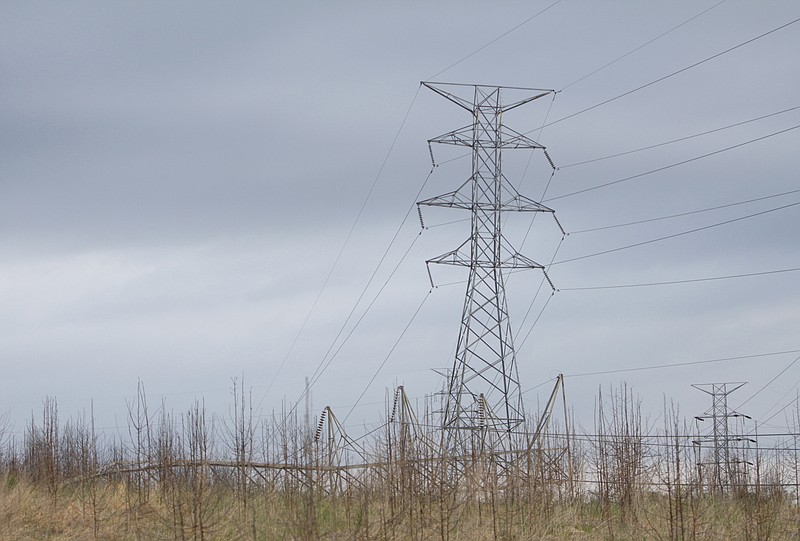The Tennessee Valley Authority was created 86 years ago to harness the power of the Tennessee River, but the federal utility will be looking to the sun for more of its power in the future as it continues to phase out its aging fleet of coal plants.
A new 20-year power plan unveiled today calls for TVA to add up to 14 gigawatts of solar generation, up to 5 gigawatts of of battery storage and between 2 to 17 gigawatts of additional natural gas-generated power over the next two decades to replace more of TVA's coal power plants being shut down.
Despite President Trump's efforts to revive the coal industry, TVA forecasters don't foresee the need in the next couple of decades for any major new baseload power plants like the nuclear and coal-fired power plants the utility erected from the 1940s through the 1990s. New generation is expected to come in more scattered forms from solar farms and rooftops, from battery and other energy storage, from more energy efficient natural gas generation, and from purchased wind and other renewable power.
The proposed new Integrated Resource Plan, which was endorsed Thursday by a variety of TVA stakeholders serving on the Regional Resource Council, is designed to serve as a guide for TVA's power planning through 2040. The proposed plan is scheduled to be adopted by the TVA board in August when directors meet in Knoxville to approve their fiscal 2020 budget.
Environmental groups praised TVA's commitment to phasing out more coal plants but said today the utility should have done more.
The Southern Alliance for Clean Energy, a Knoxville-based environmental group, criticized the plan for "gutting energy efficiency" incentives that TVA used to provide to many of its customers and for moving to higher fixed fees, which tend to discourage some solar or wind self generation by homes and businesses.
"This IRP is a missed opportunity," said Stephen Smith, executive director for the Southern Alliance for Clean Energy. "TVA is not prioritizing what is best for Tennessee Valley residents."
The Sierra Club said TVA's new power plan "still relies too heavily on risky gas, and comes up short on energy efficiency, which lowers people's bills and reduces the air and water pollution caused by burning fossil fuels."
TVA's new long-range power plan has a range of options depending upon how power demand grows or slows and what environmental regulations and limits on carbon emissions may be adopted to limit global warming.
"Of all of the plans we have done this may be the most important because of the change in our industry," TVA Chairman James "Skip" Thompson said. "Customer behaviors are changing; businesses are committing more to renewable power, and distributed energy is growing and disrupting the entire industry. So planning for the future, while it has always been important, is more important now from the balance sheet to the grid and everything between."
But the roadmap envisions slower growth, or even declines, in the demand for electricity as lights, machines and air conditioners become more efficient and homes, offices and factories become better insulated. The plan also calls for more flexbility in delivering power to the nearly 10 million people served by TVA to help keep the power on when the sun doesn't shine or the wind doesn't blow.
TVA had been updating its long-range power plans every five years, but changes in the market have led the utility to move to update its previous plan, which was finalized three years ago.
The need for a more flexible power grid and system is helping drive both TVA's decision to build a new $300 million power operations system near Georgetown and its plans to phase out two more major base load coal plants over the next four years at the Paradise plant in Kentucky and the Bull Run plant in Oak Ridge.
TVA has already shut down more than half of the 59 coal-fired units it once operated, cutting its overall carbon emissions by 55% since 2005. TVA President Jeff Lyash, who joined TVA this spring, said the utility expects to cut its carbon emissions below 2005 levels by 60% in 2020 and by 70% by 2030.
"TVA's process is as strong as I have seen in getting public and stakeholder involvement and working to develop the best plan forward," Lyash said. "Going forward, we have to leverage the technologies we have and support the development of storage technologies to support the further development of solar sources and demand-side resources."
Lyash said TVA benefits by having a balanced energy portfolio with generation from nuclear, natural gas, coal, hydroelectric dams and renwable sources such as solar and wind.
TVA's new long-range plan outlines plans to add as much as 14 gigawatts of additional solar generation, which would be more than 25 times the amount of solar generation now in the Valley.
"Solar is more and more popular and it is the energy source that people want," said Gil Hough, executive director of the Tennessee Solar Industries Association. "Even with the tariffs on solar panels, steel and aluminum, the price of solar continues to go down and I'm excited that this IRP (integrated resource plan) recognizes that change."
Contact Dave Flessner at dflessner@timesfreepress.com or at 757-6340.

